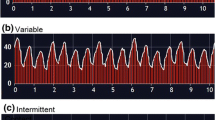Abstract
Purpose
The electrical coupling index (ECI) (Abbott, USA) is a marker of tissue contact and ablation depth developed particularly for atrial fibrillation treatment. We sought to evaluate if these measures can be also a marker of lesion efficacy during cavotricuspid isthmus (CTI) ablation for typical right atrial flutter.
Methods
We assessed the ECI values in patients undergoing typical right atrial flutter point-by-point ablation guided by the Ensite Velocity Contact™ (St. Jude Medical, now Abbott St. Paul, MN, USA) electroanatomic mapping system. ECI values were collected before, during (at the plateau), and after radiofrequency (RF) delivery. The physician was blinded to ECI and judged ablation efficacy according to standard parameters (impedance drop, local potential reduction, and/or split in two separate potentials). Patients were followed up at 3 and 12 months.
Results
Fifteen consecutive patients (11 males, mean age 69.2 ± 10.6 years) with a history of typical right atrial flutter were included in this study. A total of 158 RF applications were assessed (mean 10.5 ± 6.6 per patient, range 6–28). The absolute and percentage ECI variations (pre-/post-ablation) were significantly greater when applications were effective (p < 0.001). A 12% drop in the ECI after ablation was identified by the ROC curve as the best cutoff value to discriminate between effective and ineffective ablation (sensitivity 94%, specificity 100%). Acute success was achieved in all patients with no complications and no recurrences during follow-up.
Conclusion
The ECI appeared a reliable index to guide CTI ablation. A 12% drop of ECI during radiofrequency energy delivery was highly accurate in identifying effective lesion.



Similar content being viewed by others
References
Blomstrom-Lundqvist C, Scheinman MM, Aliot EM, et al. American College of Cardiology; American Heart Association Task Force on Practice Guidelines; European Society of Cardiology Committee for Practice Guidelines. Writing Committee to develop guidelines for the management of patients with supraventricular arrhythmias. ACC/AHA/ESC guidelines for the management of patients with supraventricular arrhythmias—executive summary: a report of the American College of Cardiology/American Heart Association Task Force on Practice Guidelines and the European Society of Cardiology Committee for Practice Guidelines (Writing Committee to develop guidelines for the management of patients with supraventricular arrhythmias). Circulation. 2003;15:1871–909.
Weiss C, Antz M, Eick O, Eshagzaiy K, Meinertz T, Willems S. Radiofrequency catheter ablation using cooled electrodes: impact of irrigation flow rate and catheter contact pressure on lesion dimensions. Pacing Clin Electrophysiol. 2002;25:463–9.
Okumura Y, Johnson SB, Bunch TJ, Henz BD, O’Brien CJ, Packer DL. A systematic analysis of in vivo contact forces on virtual catheter tip/tissue surface contact during cardiac mapping and intervention. J Cardiovasc Electrophysiol. 2008;19:632–40.
Yokoyama K, Nakagawa H, Shah DC, Lambert H, Leo G, Aeby N, et al. Novel contact force sensor incorporated in irrigated radiofrequency catheter predicts lesion size and incidence of steam pop and thrombus. Circ Arrhythm Electrophysiol. 2008;1:354–62.
Arruda MS, Cao H, Fish JM, et al. Novel tissue sensing technology predicts tissue pops and irrigated RF lesion size irrespective of contact force. Heart Rhythm. 2008;5(Suppl):S70.
Piorkowski C, Sih H, Sommer P, et al. First in human validation of impedance-based catheter tip-to-tissue contact assessment in the left atrium. J Cardiovasc Electrophysiol. 2009;20:1366–73.
Michael A, Jones MA, Webster D, et al. The benefit of tissue contact monitoring with an electrical coupling index during ablation of typical atrial flutter—a prospective randomised control trial. J Interv Card Electrophysiol. 2014;41:237–44.
Pérez F, Schubert C, Parvez B, Pathak V, Ellenbogen K, Wood M. Long-term outcomes after catheter ablation of cavo-tricuspid isthmus dependent atrial flutter: a meta-analysis. Circ Arrhythm Electrophysiol. 2009;2:393–401.
Wittkampf FH, Nakagawa H. RF catheter ablation: lessons on lesions. Pacing Clin Electrophysiol. 2006;29:1285–97.
Zheng X, Walcott GP, Hall JA, Rollins DL, Smith WM, Kay GN, et al. Electrode impedance: an indicator of electrode-tissue contact and lesion dimensions during linear ablation. J Interv Card Electrophysiol. 2000;4:645–54.
Kuck KH, Reddy VY, Schmidt B, et al. Novel radiofrequency ablation catheter using contact force sensing: TOCCATA study. Heart Rhythm. 2012;9:18–23.
Natale A, Reddy VY, Monir G, Wilber DJ, Lindsay BD, McElderry H, et al. Paroxysmal AF catheter ablation with a contact force sensing catheter: results of the prospective, multicenter SMART-AF trial. J Am Coll Cardiol. 2014;64:647–56.
Shurrab M, Di Biase L, Briceno DF, et al. Impact of contact force technology on atrial fibrillation ablation: a meta-analysis. J Am Heart Assoc. 2015;4:e002476.
Haddad ML, Taghji P, Philips T, et al. Determinants of acute and late pulmonary vein reconnection in contact force-guided pulmonary vein isolation. Identifying the weakest link in the ablation chain. Circ Arrhytm Electrophysiol. 2017;10:e004867.
Gaspar T, Sih H, Hindricks G, Eitel C, Sommer P, Kircher S, et al. Use of electrical coupling information in AF catheter ablation: a prospective randomized pilot study. Heart Rhythm. 2013;10:176–81.
Dello Russo A, Fassini G, Casella M, et al. Simultaneous assessment of contact pressure and local electrical coupling index using robotic navigation. J Interv Card Electrophysiol. 2014;40:23–31.
Holmes D, Fish JM, Byrd IA, et al. Contact sensing provides a highly accurate means to titrate radiofrequency ablation lesion depth. J Cardiovasc Electrophysiol. 2011;22:684–90.
Author information
Authors and Affiliations
Corresponding author
Ethics declarations
Conflict of interest
The authors declare that they have no conflict of interest.
Electronic supplementary material
ESM 1
(GIF 128 kb)
Rights and permissions
About this article
Cite this article
Maines, M., Peruzza, F., Zorzi, A. et al. Use of impedance-based catheter tip-to-tissue contact assessment (electroanatomic coupling index, ECI) in typical right atrial flutter ablation. J Interv Card Electrophysiol 53, 225–231 (2018). https://doi.org/10.1007/s10840-018-0375-6
Received:
Accepted:
Published:
Issue Date:
DOI: https://doi.org/10.1007/s10840-018-0375-6




